| |
| Christmas
|
|
Yuletide
|
Pease
note: This is for people 11 years and older.
For the kids version (10 and younger), click
here. |
Table of Contents
| Christmas
Definitions Christmas vs.
Yuletide What do the
words actually mean? |
Yuletide
Traditions
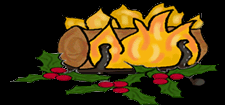
|
| Christmas
Traditions

Including the origin of the Christmas Tree!!!
|
Who
was Santa Claus?
RE: Origins of Santa Claus
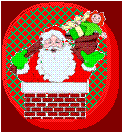
|
|
What
does the word "Christmas" mean?
*
Denotatively, "Christmas" means: "Christ's mass". It is a word of Catholic-Christian origin, meaning a
special mass (worship service) commemorating the birth of Jesus Christ. To the
Catholics it still means this, and more.
*
To the rest of Christendom, it not
only represents the celebration of the birth of Jesus Christ (even
though that's not the actual date of his birth); but also a time to spend
with families, in gift-giving, in merriment, and in giving to others.
*
To the rest of the Western World, regardless of one's religious beliefs,
it is a time to spend with
loved-ones.
*
Christmas has evolved into a whole
season that lasts a whole month from around November 25th to December
25th, with festivities for the New Year trailing.
|
|
What is Yuletide?
The word "Yule" was originally a Scandinavian
word (in Finnish it is spelled: "Joul", but pronounced the same way). Scholars say that Yule probably means
'feast', and "tide" means time (as in a period of time).
Therefore, "Yuletide" is the feasting time.
It was originally a Scandinavian winter solstice
tradition, but now is part of the Christmas traditions. Usually
both Christmas Eve and Christmas Day are accompanied by huge feasts of a usually
a big bird, like a goose (UK) or a turkey (US); Also, possibly a Christmas
ham could be prepared, accompanied by such side dishes as: mashed potatoes
and gravy, candied yams, and stuffing. For desert we would have Christmas
cookies, figgy pudding, fruit cake, and pumpkin pie (also some
festivities may include apple pie and pecan pie).
No one knows exactly how long the Yuletide lasted
in ancient times?
But,
the most important time was from December 22nd to December 25th. Solstice
means Sol (sun) stands still for three days: 22nd, 23rd, and 24th.
On December 22nd--the winter
solstice--when the sun was lowest in the sky (for the Northern
Hemisphere), it was thought that the sun was close to death. It
was the tradition to keep a yule log (or yule logs) lit for three days
to re-ignite the sun. On December 25th, when the sun started to
appear higher in the sky, it was thought to be the "Birthday of the SUN".
In modern times, for those who actually have fire places, it is a
tradition to light the Yule Log on Christmas Eve.
Click
here to see Yule Traditions
That have become a part of X-mas Traditions
|
Who was Santa Claus?
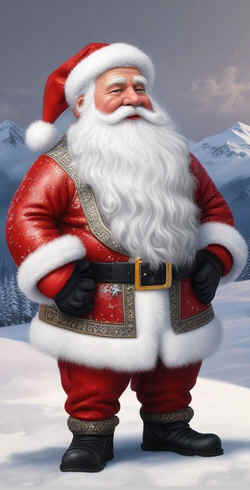 |
Santa
Claus?
St. Nick?
Kriss Kringle?
Grand-Dad Frost?
Who
were those guys?
Were
they the same person?
Where
did they come from?
|
The modern-day Santa
Claus appears to be a combination of 4 historical personages:
Here they are (in no particular order):
1. Joulupukki (Finland);
Jultomten (Sweden); Jolasveinar (Iceland)
2. The Russian 'Grand-dad Frost' (Ded Moroz)
3. A Catholic Bishop (St. Nicholas)
4. Kriss Kringle (Kristkindl)
Icelandic/Finnish
Evil Gnome/Ogre
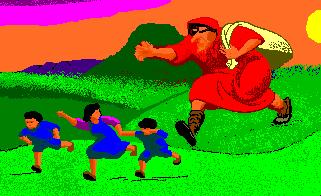
Modern-day
Finnish Joulupukki

|
Joulupikki:
There is a very old Finish
legend of an evil gnome with god-like powers, named Jouluppukki.
Jouluppukki was ORIGINALLY a really bad guy. He came from the
north, flying or riding on some beast (possibly a goat or a buck, as joulupukki means yule buck). He would demand gifts from the people
of Finland and if these gifts were not satisfactory, Joulupukki would
reak havoc upon the people.
There is a similar tradition in
Iceland. There was an family of evil ogres (called Jolasveinar),
who would capture and allegedly eat children, if the gifts of the people
were not satisfactory. In time, the story was changed such that
only naughty children were captured. The story was perpetuated to
make children behave.
My comment:
The idea that "Santa Claus" was once a bad guy is not a
pleasant one. But, truth is sometimes stranger than fiction.
Perhaps over time the story changed to make the Gnome bring gifts for
good children, instead of eating bad ones.
Sources:
http://en.wikipedia.org/wiki/Joulupukki
http://www.nordicway.com/search/Santas_Nordic.htm
http://www.simnet.is/gardarj/folk/jola.htm
|
Ded
Moroz
(and the Snegurochka)
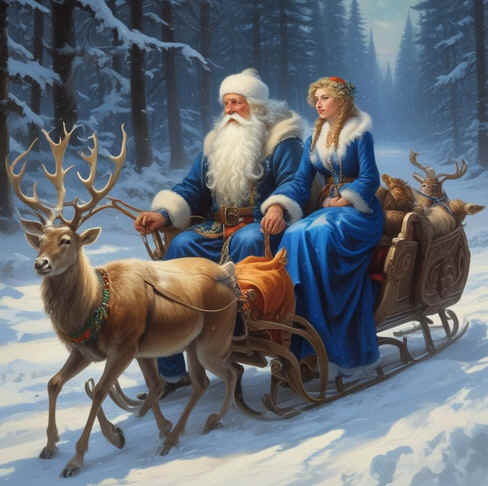
|
Grand-dad
Frost
(and the Snow Maiden)
Grand-dad Frost
brings gifts to good little children on January 1st in Russia, Mongolia,
and many of the former Soviet satellites of Russia.
Sometimes Grand-dad
Frost wears red, and sometimes he wears blue. He looks very much
like today's Western 'Santa Claus'. He also performs the same
function.
Was our Western
'Santa Claus' borrowed from "Ded Moroz" and used at Christmas
time, rather than at New Year's time?
Could be!
Right? |
| Saint
Nick
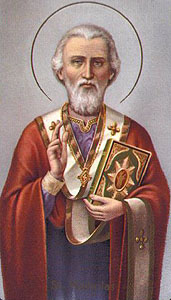
|
A Catholic
Bishop become Saint:
There was a Catholic
Bishop named Nicholas, who was stationed in Myra, in present-day Turkey,
who was said to have been extremely benevolent to children. After
his death he was beatified by the pope and he became the patron saint of children.
December 6th is St. Nicholas Day in many countries, including Belgium,
Netherlands, & Poland.
Source: Wikipedia |
 |
Kriss
Kringle:
Kriss Kringle is said to be a
modification of the German word: Kristkindl, which means Christ
Child. In Germanic countries, the Christ Child is said to visit
good little children with gifts around Christmas time. Apparently there was no guy named
Kriss Kringle.
Source:
http://www.infoplease.com/dictionary/brewers/kriss-kringle.html
|
|
Most
Christmas Traditions
are
Winter
Solstice Traditions
by
Leon
Did
you know that Winter solstice traditions are remarkably similar around the
northern hemisphere? And did you know that
most of our Christmas traditions come from those winter solstice
traditions? In this article,
we shall explore the various winter solstice traditions around the world.
Winter
begins with the winter solstice, on the 22nd day of December in the
Northern hemisphere, the day when the sun is lowest in the sky and
daylight is shortest. The word
“solstice” is a compound word from Latin meaning “Sun stands
[still].” Starting on
December 22, and lasting three days, the sun literally stands still from
our perspective. Then, on
December 25, it starts to rise higher in the sky, as if it had been born
again. That is why Christmas
is on December 25. Since the
sun is the literal light of the world, and since the Christ was the
metaphorical light of the world, it seemed appropriate to the founders of
Christianity to set Christ’s birthday on that auspicious day.

The
Origin of...
the Christmas
Tree
Almost
every culture has had a winter solstice tradition.
My personal favorite winter solstice tradition is the Mongol
tradition. So, let’s start
with that one. Mongols call
the winter solstice the Uvliin Toil.
Uvliin means
winter’s; and Toil means both
(a) climax; and (b) pole. Interestingly,
Toilakh means to be at the end
of one’s rope, to become completely exhausted.
To me it signifies a double entendre:
The sun has reached the end of its rope, and it is exhausted from
its work.
According
to an article by Jade Wah’oo Grigori, entitled:
“A Time of the Shaman’s Gift Bringing;” the traditional
Mongol winter solstice is a very, very, meaningful and important time
for all Mongols who still follow the old ways.
It is written that the Mongol village shaman was (and still is to
some Mongols who follow the old ways) very central and important to the winter solstice ritual.
Villagers gather at the shaman’s ger,
a circular tent or yurt (as it is called in Turkey).
A ger has a central pole which represents the ‘mother tree’,
called “Ej mod.”
It is called other things too, like the “Tree of Life” and the
“Pole of Ascension.” The
ger’s ceiling is supported by 81 ribs, representing the 9-times-9
pillars which hold the heavens apart from the earth.
The ‘mother tree’ points to the North Star, figuratively of
course. So, at the top of the
‘Tree of Life’ sits the ‘Star’ (north star).
Is
that the origin of our "Christmas Tree" tradition (or does it go
back even further in time)? My thoughts are that it goes back even
further. For instance, the prophet Jeremiah mentions the practice of
the pagans to decorate trees with silver and gold and worship them as
idols. Jeremiah lived from 650 B.C. to 670 B.C. ALSO, there is some
extra-Biblical evidence that the origin
of the Christmas tree may go all the way back to Nimrod's Mother.
But, I'll get to that later.
BUT,
BACK TO THE MONGOLS...
PLEASE NOTE: that due to both Chinese and Russian influence (both
Countries having had a turn at ruling Mongolia), most Mongolians nowadays
are atheists. There are probably about 30 percent of the population
who follow Tibetan Buddhism (that's my estimate from living there for 5
years). And, my estimate of those who follow Shamanistic practices
is about 10-15% of the population. So, when I speak of Mongolian
traditions regarding the Tree of Life and the North Star, this has for the
most part fallen out of tradition.
Mongols
traditionally have believed that the abode of each person’s soul is a
different star. Superstitiously,
Mongols have traditionally believed that a falling star represents the
death of some individual on Earth. The
unmoving, eternal North Star is the abode of the Great Spirit.
It is also referred to as the “Heart of the eagle” or the
“Compassionate heart of purification”.
Each winter solstice the ancient Mongols sent their soul to the North
Star for purification. If
they didn't know how to do it, the services of a Shaman could be
invoked (and obviously these services weren't free of charge).
One
of the ancient traditions involved
villagers gathering in the shaman’s tent, having brought gifts and placing
them under the “mother tree”. In
return for the gifts, the shaman undertakes a spiritual journey to the
North Star with his culpable clients’ souls for the purpose of
purification. This is the
reason that we put gifts under the Christmas tree today.
Then,
when the Shaman returns with his cleansed clients’ souls, the Mother
Tree shimmers with the light of each purified soul, reawakened to or
renewed by the light of the North Star.
This is the origin of the tradition of putting Christmas lights on
the Christmas tree.
TODAY,
Mongolians put up Christmas trees with lights, not remembering the reason
for doing so. It is just a tradition. And, due to Russian
influence of the Grand-Dad Frost, the Mongolian version of
Grand-Dad-Winter comes on New Year's day delivering presents to the
children.
_______________________________________________________________________
Yule
Traditions

Yule
Log
Scandinavian tribes had their Yuletide
traditions. Yule
means feasting, and tide means
time (period of time). The Scandinavian
tribes have given us the following Yuletide traditions:
(1) Feasting, (2) Keeping the Yule log lit all night on the 24th of
December, and (3) Hanging mistletoe.
Why
do we have feasts at Christmas time?
All we know is that it was a Scandinavian Yuletide tradition. As to
why they started it--I don’t think
anyone really knows. My
best guess would be that due to very little daylight and such bitter cold, there was nothing
else to do but stay indoors. Since
they didn’t have television or internet in those days, my guess is that
indoor activities were limited to eating, drinking and being merry.
Why
must one keep the Yule log burning all night on the 24th of
December? The answer is to
re-ignite the Sun. The
fallacious fear was that if one did not keep the Yule log burning all
night long, the Sun would not be reborn on the 25th of December.
As a result, the world would plunge into eternal darkness and all
creatures would die. My question: If we keep the
Yule log burning all night long, how does Santa get down the
chimney? Answer: In Scandinavia, Santa doesn't come down the
chimney. He knocks on the door, and asks, "Are there any good
children here?"
Why
do we hang mistletoe at Christmas time?
It is because of the Scandinavian myth about Balder and Loki.
Balder was the god of truth and light (a solar deity); He was the personification of the
Sun. Loki was the god of
mischief and chaos; He was the personification of darkness and the chaotic cosmic
sea (that we know today as "space").

Balder
& Loki & Mistletoe
The myth goes like this:
Balder’s mother, Frigga (which means "Love") had asked all the plants,
animals and minerals of earth never to
harm her son, Balder. However, there was one plant that she overlooked; it was
mistletoe. Frigga said she
overlooked it because it was so soft and wouldn't hurt anything.
Over time, Loki became jealous
of Balder’s popularity and he was annoyed by the noise devoted to
Balder’s praise. So, he
clandestinely disguised himself as an old hag and visited Balder’s
mother. Through their
conversations, he found out that there was one and only one living thing
on Earth that she had not made promise never to harm her son.
Loki then made an arrow out of mistletoe; and one day when the gods
were hurling various things at Balder, just to see how nothing could hurt
Balder. Loki, disguised as an old hag, gave the mistletoe arrow to
Hod (a blind god) to hurl at Balder, and it killed Balder.
Three
days later, after much mourning, Balder’s mother sent Balder's brother,
Hermod, to go into Hel (Hel = the afterlife) to rescue Balder, and he was resurrected
by Frigga. Finally, Frigga made mistletoe promise to never harm another living
thing. This is why mistletoe
is used as decoration at winter solstice time.
It is the symbol of peace and love and tranquility.
______________________________________________________________________
Brumalia
Why
is Christmas a Whole Season?
But,
why do we celebrate Christmas for a whole month, starting with the day
after Thanksgiving. Well, that
tradition came from the Romans. Before
the winter solstice traditions were merged with Christmas, the Romans had
a winter solstice tradition called Brumalia.
According to Rober Maza’s research, Brumalia was originally
celebrated only on the 24th and 25th of December to commemorate the “sol
invictus” (the invincible sun).
It celebrated the Sun’s victory over death.
Later, the holiday became associated with the Roman Sun god Bacchus
(same as the Greek god Dionysus) and it was celebrated the whole month of
Bacchus (December). In
addition to being a Sun god, Bacchus was the liberator of life’s burdens
through imbibing and making merry.
In
conclusion, our world’s winter solstice traditions, by whatever name,
are full of wonderful meaning. Sadly,
it is a meaning that has been almost completely lost.
It my sincere hope that we revive the original meanings of the
winter solstice traditions, so that they are not lost to posterity.
Let us remember that our Christmas trees have very ancient
Mongolian roots; that the star at the top of the tree represents
purification of our hearts and souls; that our Scandinavian Yule logs have
kept the Sun burning for millennia; And, that the mistletoe which hangs
from our ceilings symbolizes love, peace, and tranquility.
Please tell these stories to your children, so that they may tell
them to their children.
Source: Wikipedia
|
| A
wish from Leon...
Finally,
as we approach the coming winter solstice, may our hearts and souls be
purified by the light of the Great Spirit; may Sun be reborn again to give
its life-giving light unto the world for another year; and may we all
experience eternal love, peace, and tranquility.
|
|
Another
possible origin of the
Christmas Tree

As promised (above) I shall go into the idea
that Nimrod's Mother started the tradition of the Christmas Tree. The
dates are disputed. For instance the Bible places Nimrod to 2000 years
B.C. (two generations after the great flood). and the Bible places the great
flood at 2300 B.C. But, I do not believe that the Bible has accurate
timing. I DO believe that all the event happened, but the timing got
messed up somewhere along the way. I believe that the great flood
probably happened around 10,000 B.C. when the ice age ended, the Earth heated
up (for some reason), and great flooding happened all around the planet.
So, if this story about Nimrod's Mother is
true, then it is the oldest story of the Christmas Tree tradition ever told. The
Torah (Jewish Bible) tells a story of how Nimrod (who was son of Cush,
who was son of Ham, who was son of Noah) aspired to build a
tower to reach heaven. ...to stand face to
face before his maker(s), and be able to converse with him/them as one person
converses with another.
But something went terribly wrong.
Maybe something like what happened to the space shuttle Challenger occurred, and
the people naturally attributed the failure of the "tower" to celestial beings.
After that, the Bible doesn't tell us what happened to Nimrod, but in an extra-biblical
book, I read the rest of
the story...
THE REST OF THE STORY:
Well, eventually Nimrod died. How he died is not
clear. And, he was survived by his mother, who became the reigning
Queen. She loved her son so much, that she had an evergreen tree planted
at his burial site and decorated it with silver and gold each December 25th, his
birthday. Then, one day, she commanded that everyone in her "Queendom" must
have a tree in/at their home and decorate it with silver and gold on her son's
birthday.
That story comes from a book that I once
read, which is gone. I wish I still had it, and I wish I could remember the
title, but I remember what it was about. It was all about the cross symbols
in ancient cultures/civilizations (not just the Christian religion). So,
the author was convinced that an evergreen (coniferous) tree was a phallic symbol; It
symbolized manhood, which is why it was chosen by the queen (Nimrod's mother);
for her son was a
MAN. [I think the title of the book was something like: "The
Cross in Ancient Religions" or "The Ancient Symbolism of the Cross".
I don't remember the actual title, nor the author. It was printed in the
40's or 50's and is probably long out of print ('cause I've looked for it
online and can't find it).
___________________________
POST NOTE: When I first wrote
this page (including the story of Nimrod and the evergreen tree) in 2000, I
searched on the
internet, I could NOT find anything to corroborate this story. But,
as of December 16, 2006, I googled
"Nimrod birthday December 25" and
56,600 websites came up. So, I guess by now it has become an accepted
fact. [As of 2016, 102,000 I got results for the same search]. [As of
November 8, 2021, Google gave 433,000 results for "Nimrod's birthday
December 25th".]
|
More X-mas Traditions
Decorating
the Houses with Lights:
Every year, right after Thanksgiving
(generally during Thanksgiving weekend, but sometimes before),
Americans decorate the exterior of their homes with lights, which
stay up until after Christmas day (sometimes until New Year's Day).
This probably originated with the festival of lights, which occurred in December of each year.
It seems to be the general
consensus that this tradition came from the Roman winter solstice tradition
called Saturnalia, but many cultures have had (as some still do) a festival of
lights. Hanukah is a festival of lights. Diwali is a festival of
lights.
Source: Wikipedia
Christmas
Caroling
(AKA: Wassailing)

Wassailing [UK] or 'Christmas Caroling'
[US] involved singing and making merry. Currently, in America, Christmas
caroling is done by Christian groups as a form of proselytizing... or... in some
cases... just for the fun of it.
The following website suggests that the
tradition of Christmas caroling for food/drink (as in the traditional carol:
"We wish you a merry Christmas") comes from the Celtic tradition of
Wassailing. Wassailing apparently was the practice of singing to wish
fellow farmers well in the upcoming planting season, for which they were
rewarded by a cup of wassail (an alcoholic drink).
Source: The
Secular Web; Kiosk
For the lyrics of some modern Christmas carols/songs,
click here.
|
X-mas
FAQs
|
| Q1.
Why is Christmas sometimes written "X-mas"? |
| A1. Because
"Christ" in Greek is written: "Xpist";
So, Christ-mas became X-mas. |
| Greek: |
 |
|
|
|
| Q2. Why are green
and red the colors of Christmas? |
| A2. Good question! I don't think
anybody really knows anymore. But, if I had to guess, I'd say, that green
represents the evergreen Christmas tree, which represents eternal life.
Red usually represents blood. It might represent the blood that Christ
gave so that all might have eternal life. But, I'm just guessing. |
|
|
| Q3. Why does Santa come down chimneys
and put presents in stockings hung on the chimney mantle piece? |
|

|
| A3. Coming down the chimney probably started
because doors are usually locked at night. Why the stockings are present receptacles
is anybody's guess. Seems kind of a stinky place to put presents, doesn't
it? I highly doubt it has anything to do with Bergermeisters (or
any person like them) outlawing toys. It probably stems from
most people being too poor to have Christmas trees in their homes and
since Santa Came down the chimney, of course, he would notice the
stockings hung from the fireplace to dry.
NOTE: Many European countries have the tradition
of putting out shoes on Christmas Eve to be filled with goodies by Saint
Klaus (or Papa Noel in France). In some countries, they put snacks
for Saint Klaus, and Saint Klass exchanges the treats for
presents. In the Netherlands, they put out wooden shoes. In
some countries they put out shoes by the fireplace. In some
countries, they put out shoes on the window sill. In some
countries, they put out shoes on the porch.
PERHAPS: ...My best guess is that perhaps, back
in the old times of USA, people were poor and could only afford one pair
of shoes, but they had more than one pair of stockings. So, they
traded the tradition of putting out their stinky, dirty shoes, for
hanging up clean stockings.
|
|
|
| Q4. What if somebody lives in an apartment
with NO chimney? |
| A4: Parents have to stay awake until Santa
comes and let him in the door. |
|
|
| Q5. What is the best Christmas present
(to give)? |
| A5: Put yourself in the shoes of the person
for whom you want to give a present, and think about what he/she would like to
receive for Christmas. That is the best Christmas present. |
|
|
| Q6. Are there any romantic traditions
associated with Christmas? |
| A6: It is a special day for all, but
especially for lovers. The traditions are the same...such as: exchanging
gifts and decorating the Christmas tree together. It is also a time for
new lovers to start making Christmas traditions of their own, which will
be perpetuated and passed on to their children (if they get married). |
|
|
| Q7.
Why do European people (or people of European descent) hang mistletoe at
Christmas time? |
|

|
|
A7: Well, let
me quote from an article on About.com:
"Baldur's mother was the
Norse goddess, Frigga. When Baldur was born, Frigga made each and every
plant, animal and inanimate object promise not to harm Baldur. But
Frigga overlooked the mistletoe plant -- and the mischievous god of the
Norse myths, Loki, took advantage of this oversight. Ever the prankster,
Loki tricked one of the other gods into killing Baldur with a spear
fashioned from mistletoe. The demise of Baldur, a vegetation deity in
the Norse myths, brought winter into the world, although the gods did
eventually restore Baldur to life. After which Frigga pronounced the
mistletoe sacred, ordering that from now on it should bring love rather
than death into the world. Happily complying with Frigga's wishes, any
two people passing under the plant from now on would celebrate Baldur's
resurrection by kissing under the mistletoe."
FROM: http://landscaping.about.com/cs/winterlandscaping1/a/mistletoe_2.htm |
|
|
| Q8. What about family traditions
associated with Christmas? |
| A8: Yes, each family has its own traditions
for Christmas. Each member of my family was allowed to open one
gift on Christmas eve. Also, we had a big feast on both Christmas eve AND
Christmas day. |
|
|
| Q9. What are some traditional foods
associated with Christmas? |
|
A9: There are only a few food that
are particularly associated with Christmas. They are:
- fruit cake (which I could live without)
- sugar cookies (which are cut into shapes of X-mas symbols; very
delicious!)
- figgy pudding {...according to the ol' X-mas carol; I've never tried
it. Now, one must understand (if one is from North America) that in the
old days (and still in the UK and most of its "commonwealth") pudding
was/is a kind of muffin. Thus, figgy pudding would have been a muffin with
fig-treats in it.}
- goose or turkey (Like Thanksgiving, the main course tends to be a big bird;
traditionally a goose or turkey, but duck, or chicken can be
substituted; In our family, turkey was eaten instead of goose.)
|
|
|
| Q10. How do reindeer fly? |
| A10: I don't know for sure. Possibly, this idea comes from the
ancient traditions of many ancient peoples that the gods flew in a
chariot pulled by four-legged beasts (Nordic myth of Thor and Tibetan myth of
Gesar and Hindu myth of Mithra). |
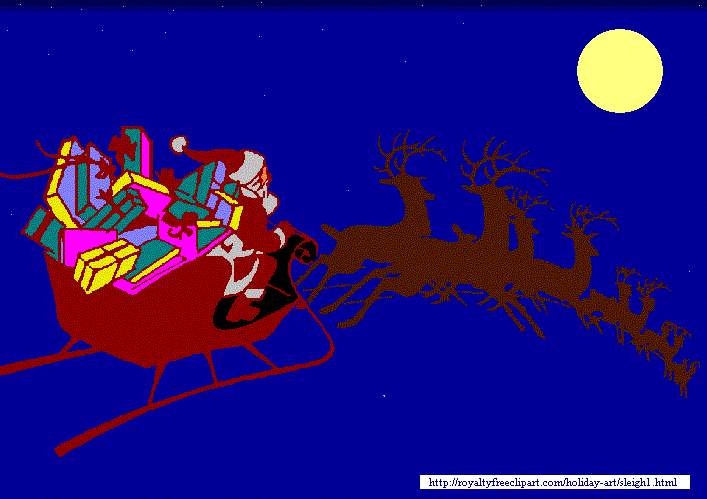
A
Merry Christmas to all, and to all a goodnight!
See also, Leon's webpage about...
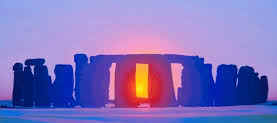
Winter Solstice Traditions Around the World
| |

English |
|

Spanish
|

Korean |

Mongolian |

Chinese |
|

Parents of
Homeschool
|
|

Halloween
|
|

Thanksgiving
|
|
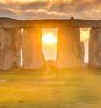
Winter Solstice
|
|

Christmas
|
|

New Years
|
|
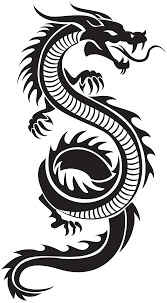
Chinese Lunar
New Year
|
|

Valentine's
|
|

|
|
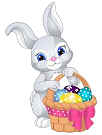
Easter
|
|

All About
Dr. Seuss
|
|
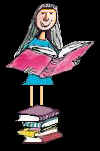
Roald Dahl
|
|
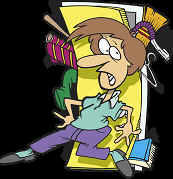
Prepper's
Pen |
|

Ways to
Help
Leon's Planet
|
|